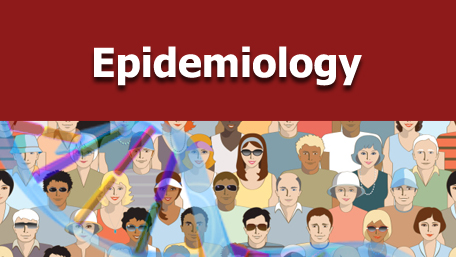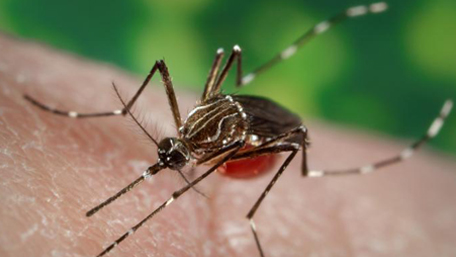
Two Genetic Markers that Predict Malaria Treatment Failure Found
November 3, 2016
A frontline malaria treatment that combines fast-acting dihydroartemisinin with long-lasting piperaquine is quickly losing power in Cambodia due to the rapid spread of drug-resistant parasites. The presence of piperaquine-resistant malaria parasites in several Cambodian provinces was confirmed earlier this year by National Institutes of Health researchers and their colleagues. Now, by comparing the complete genomes of 297 parasites isolated from Cambodian malaria patients to a reference malaria parasite genome, the team has identified two genetic markers that are strongly associated with the parasites’ ability to resist piperaquine.
A simple test, performed after collecting blood from a finger pinprick, can show whether a malaria patient has parasites with the genetic markers. If so, dihydroartemisinin-piperaquine therapy is likely to fail, say the study authors, and an alternative drug combination (artesunate-mefloquine) should be used. Information about the distribution of these drug resistance markers is being used by officials in Cambodia and neighboring countries to map the extent and spread of piperaquine resistance and to help guide region-wide malaria treatment approaches.
National Institute of Allergy and Infectious Diseases (NIAID) scientist Rick Fairhurst, M.D., Ph.D., and Roberto Amato, Ph.D., of the Wellcome Trust Sanger Institute (WTSI), Cambridge, UK, led the research team. The first marker they identified is a change of one subunit in a gene on the parasite’s chromosome 13. Parasites with this genetic change are much more likely to be resistant to piperaquine than parasites without it. The marker, while associated with drug resistance, likely does not play a functional role in enabling parasites to resist piperaquine, according to the researchers. In contrast, the second resistance marker identified by the investigators may have such a role. That marker is an increased number of copies of two genes (plasmepsin II and plasmepsin III) in those parasites that resist piperaquine. Malaria parasites use plasmepsins to help them digest human blood and, although the exact mechanism of action of piperaquine is not known, it is believed that the drug targets plasmepsins. Parasite
s may react to piperaquine by increasing plasmepsin production, and any parasites with extra copies of the plasmepsin II and III genes may be better able to withstand piperaquine treatment. Of note, parasites with increased piperaquine resistance appear to have increased susceptibility to the malaria drug mefloquine. This observation hints at the possibility of devising malaria treatment regimens that combine three or more drugs to exploit opposing resistance-susceptibility attributes.
s may react to piperaquine by increasing plasmepsin production, and any parasites with extra copies of the plasmepsin II and III genes may be better able to withstand piperaquine treatment. Of note, parasites with increased piperaquine resistance appear to have increased susceptibility to the malaria drug mefloquine. This observation hints at the possibility of devising malaria treatment regimens that combine three or more drugs to exploit opposing resistance-susceptibility attributes.
In addition to NIAID and WTSI scientists, the team included investigators from the National Center for Parasitology, Entomology and Malaria Control in Phnom Penh, Cambodia, and from Mahidol University in Bangkok, Thailand.
ARTICLE:
R Amato et al. Genetic markers associated with dihydroartemisinin-piperaquine failure in Plasmodium falciparum malaria in Cambodia: a genotype-phenotype association study. Lancet Infectious Diseases DOI: 10.1016/S1473-3099(16)30409-1 (2016).
R Amato et al. Genetic markers associated with dihydroartemisinin-piperaquine failure in Plasmodium falciparum malaria in Cambodia: a genotype-phenotype association study. Lancet Infectious Diseases DOI: 10.1016/S1473-3099(16)30409-1 (2016).
WHO:
Rick M. Fairhurst, M.D., Ph.D., Laboratory of Malaria and Vector Research, NIAID, is available to discuss this research.
Rick M. Fairhurst, M.D., Ph.D., Laboratory of Malaria and Vector Research, NIAID, is available to discuss this research.


Last Posted: Nov-04-2016 2PM

Last Updated: Nov 04, 2016
- Two Genetic Markers that Predict Malaria Treatment Failure Found
NIAID, November 3, 2016 - Haplotype analysis of ?-thalassemia chromosomes reveals heterogeneity and multiple founders in Ashkenazi Jews.
Shaulov Adir, et al. European journal of medical genetics 2016 10 - Advanced Molecular Detection of Malarone Resistance.
Talundzic Eldin et al. Antimicrobial agents and chemotherapy 2016 Jun (6) 3821-3 - Immunomic approaches for antigen discovery of human parasites.
Kassegne Kokouvi et al. Expert review of proteomics 2016 Oct - Molecular basis of human cerebral malaria development.
Wah Saw Thu et al. Tropical medicine and health 2016 33 - Recent advances in malaria genomics and epigenomics.
Kirchner Sebastian et al. Genome medicine 2016 Sep (1) 92 - Phenotyping and genotyping of CYP2C19 using comparative metabolism of proguanil in sickle-cell disease patients and healthy controls in Nigeria.
Adejumo Olufunmilayo E, et al. Pharmacology research & perspectives 2016 10 (5) e00252 - Triggering receptor expressed on myeloid cells 1 (TREM-1) and cytokine gene variants in complicated and uncomplicated malaria.
Adukpo Selorme, et al. Tropical medicine & international health : TM & IH 2016 9 - Failure of dihydroartemisinin plus piperaquine treatment of falciparum malaria by under-dosing in an overweight patient.
Roseau Jean Baptiste, et al. Malaria journal 2016 0 479 - Genetic Characterisation of Plasmodium falciparum Isolates with Deletion of the pfhrp2 and/or pfhrp3 Genes in Colombia: The Amazon Region, a Challenge for Malaria Diagnosis and Control.
Dorado Erika Jimena et al. PloS one 2016 (9) e0163137 - The Genetic Basis of Host Preference and Resting Behavior in the Major African Malaria Vector, Anopheles arabiensis.
Main Bradley J et al. PLoS genetics 2016 Sep (9) e1006303 - Recent advances in malaria genomics and epigenomics
S Kirchner et al, Genome Medicine, September 7, 2016 - Naturally Acquired Binding-Inhibitory Antibodies to Plasmodium vivax Duffy Binding Protein Are Associated with Clinical Immunity to Malaria in Rural Amazonians.
Nicolete Vanessa C, et al. The Journal of infectious diseases 2016 8 - Non-falciparum malaria in Dakar: a confirmed case of Plasmodium ovale wallikeri infection.
Diallo Mamadou A et al. Malaria journal 2016 15(1) 429 - Markov chain Monte Carlo and expectation maximization approaches for estimation of haplotype frequencies for multiply infected human blood samples.
Ken-Dror Gie, et al. Malaria journal 2016 0 (1) 430





- Guidelines (0)
- Tier Table (3)
- Synthesis (1)

- Human (0)
- Pathogen (2)
 Malaria
Malaria




















.jpg)









No hay comentarios:
Publicar un comentario